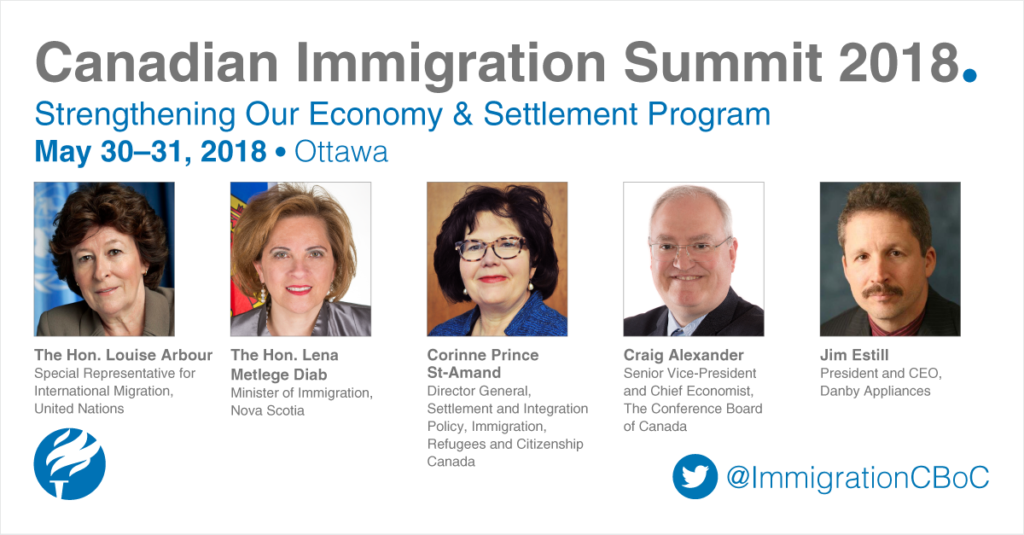Canada’s 2018-2020 immigration plan is a step in right direction, but more work is needed
By Kareem El-Assal, Senior Research Associate, Immigration The Conference Board of Canada
In November 2017, the federal government tabled just the second multi-year immigration plan in Canadian history. In a forthcoming Conference Board of Canada study, we find that the 2018-2020 immigration plan puts us on the right track in terms of helping Canada mitigate the negative economic and fiscal impacts of its aging population and low birth rate.
The plan will see Canada up its intake from some 290,000 newcomers last year to 340,000 by 2020. Our new report shows that immigration will become increasingly important to Canada’s economic growth. In 2017, Canada’s economy grew by an impressive three per cent—largely driven by strong consumer spending, a hot housing market, and the fastest employment growth in a decade. The situation has brought Canada’s unemployment rate to the lowest level on record—accelerating the fundamental labour market challenges related to retiring baby boomers.
Our current demographic trends suggest that immigration will account for an estimated one-third of Canada’s real GDP growth by 2030. If not for immigration, Canada’s population growth would slowly erode. Our natural increase, calculated by subtracting the number of deaths from births, is forecast to turn negative by 2034. This situation has already materialized in Atlantic Canada which has resulted in difficult economic and fiscal prospects for the region.
Growing Canada's labour force essential
It is important to note, however, that population growth is not the key objective to supporting a flourishing economy. Rather, an important goal is to grow the labour force to have enough workers to keep our economy moving and pay the taxes we rely upon to fund important social priorities such as education and health care. Labour force and productivity growth are the two components that allow Canada to increase its economic output and living standards. In recent years, immigration has accounted for 90 per cent of labour force growth and will soon account for all of it as more baby boomers exit the workforce. We project that Canada will need to up its intake to some 400,000 immigrants annually around 2034 (when natural increase turns negative) to help sustain healthy labour force and economic growth.
But, the relationship between immigration and economic growth is not so simple as “more is better.” More important is to ensure the success of new Canadians in the workforce. In a 2016 study, we found that immigrants lose up to $12.7 billion in wages each year due to employment barriers. We must tackle this challenge to ensure better outcomes for immigrants and our economy.
Fortunately, Canada has taken positive steps on this issue. The Express Entry application management system is more dynamic which allows employers to hire immigrants overseas and bring them to Canada in six months or less. Its quick processing standard encourages employers to use the immigration system and attaches immigrants to jobs in their field. The Provincial Nominee Program has grown in prominence since becoming permanent in 1998 and helps match immigrants with the employment needs of Canada’s provinces and territories.
Other promising developments include more pre-arrival information and settlement supports for newcomers, and Canada facilitating more immigration pathways for temporary residents such as through the Quebec Experience Program—research shows that international students and temporary foreign workers integrate very well into Canada’s economy.
Improving labour market performance of immigrants
Nonetheless, we have much more work to do. For instance, employers continue to report challenges using the immigration system so we need to identify how we can make it easier for them. We can, for example, introduce a ‘trusted employer’ program to expedite the selection process. We are already doing this on a smaller scale through the Atlantic Immigration Pilot and Global Talent Stream. We also need to encourage Canadian employers to give immigrants a fair shot. It is understandable why some may be hesitant to hire immigrants but it is critical for us to help them appreciate that immigrants are skilled, motivated, and can provide employers with a competitive edge.
Canada’s immigrant intake has been the subject of intense scrutiny throughout our country’s history and remained a hot topic leading up to the November 2017 announcement. But, the actual number of new Canadians that we welcome is not as important as the key issue: what we do with them. We must place more focus on improving their labour market performance so that the rising inflow produces greater economic benefits for immigrants and Canadians alike.
Join us at the Canadian Immigration Summit 2018
Join us in Ottawa on May 30-31, 2018, to explore how we can make our immigration system even stronger. Featured speakers include the Hon. Louise Arbour, UN Special Representative for International Migration, the Hon. Lena Metlege Diab, Minister of Immigration for Nova Scotia and Corinne Prince St-Amand, Director General for Settlement and Integration Policy with Immigration, Refugees and Citizenship Canada.
CanadaVisa.com is a proud sponsor of the Conference Board’s 4th annual Canadian Immigration Summit.
Register for the Canadian Immigration Summit 2018.

Kareem El-Assal is Senior Research Associate, Immigration, with the Conference Board of Canada
Kareem El-Assal manages the Conference Board's immigration research and annual Canadian Immigration Summit. Kareem's research covers various areas including permanent resident selection, settlement and integration, temporary foreign worker programs, refugees, international students, intergovernmental relations, and entrepreneur and investor programs. He often shares research findings with the media.
© 2018 CICNews All Rights Reserved
- Do you need Canadian immigration assistance? Contact the Contact Cohen Immigration Law firm by completing our form
- Send us your feedback or your non-legal assistance questions by emailing us at media@canadavisa.com






